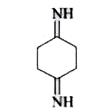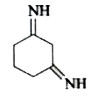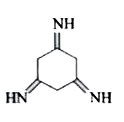Which of the following has the least tendency to dimerise ?
NO2
ClO3
ClO2
Mn(CO)5
The correct Answer is:C
To determine which of the given compounds has the least tendency to dimerize, we will analyze each compound based on its structure and the presence of unpaired electrons.
1. Analyze NO2:
- Structure: NO2 has a nitrogen atom bonded to two oxygen atoms, with one of the bonds being a double bond and the other a dative bond.
- Unpaired Electrons: There is one unpaired electron in the nitrogen atom, which makes NO2 highly reactive.
- Dimerization: NO2 readily dimerizes to form N2O4 (dinitrogen tetroxide) due to the presence of this unpaired electron.
2. Analyze ClO3:
- Structure: ClO3 consists of a chlorine atom bonded to three oxygen atoms, with one of the bonds being a double bond.
- Unpaired Electrons: ClO3 also has an unpaired electron.
- Dimerization: ClO3 can dimerize to form Cl2O6 (dichlorine hexoxide), indicating a tendency to dimerize.
3. Analyze ClO2:
- Structure: ClO2 has a chlorine atom bonded to two oxygen atoms, with one double bond and one unpaired electron.
- Unpaired Electrons: The unpaired electron in ClO2 is delocalized, forming P-Pi-D-Pi bonds.
- Dimerization: Due to this delocalization, ClO2 has a reduced tendency to dimerize compared to NO2 and ClO3.
4. Analyze MnCO5:
- Structure: MnCO5 is a metal carbonyl complex where manganese is surrounded by five carbon monoxide ligands.
- Dimerization: MnCO5 tends to dimerize to form Mn2CO10 to achieve a stable electron configuration equivalent to that of a noble gas. This indicates a tendency to dimerize.
5. Conclusion:
- Among the compounds analyzed, ClO2 has the least tendency to dimerize due to the delocalization of its unpaired electron, which stabilizes the molecule and reduces its reactivity compared to the others.
Final Answer:
The compound with the least tendency to dimerize is ClO2.
- Structure: NO2 has a nitrogen atom bonded to two oxygen atoms, with one of the bonds being a double bond and the other a dative bond.
- Unpaired Electrons: There is one unpaired electron in the nitrogen atom, which makes NO2 highly reactive.
- Dimerization: NO2 readily dimerizes to form N2O4 (dinitrogen tetroxide) due to the presence of this unpaired electron.
- Structure: ClO3 consists of a chlorine atom bonded to three oxygen atoms, with one of the bonds being a double bond.
- Unpaired Electrons: ClO3 also has an unpaired electron.
- Dimerization: ClO3 can dimerize to form Cl2O6 (dichlorine hexoxide), indicating a tendency to dimerize.
- Structure: ClO2 has a chlorine atom bonded to two oxygen atoms, with one double bond and one unpaired electron.
- Unpaired Electrons: The unpaired electron in ClO2 is delocalized, forming P-Pi-D-Pi bonds.
- Dimerization: Due to this delocalization, ClO2 has a reduced tendency to dimerize compared to NO2 and ClO3.
- Structure: MnCO5 is a metal carbonyl complex where manganese is surrounded by five carbon monoxide ligands.
- Dimerization: MnCO5 tends to dimerize to form Mn2CO10 to achieve a stable electron configuration equivalent to that of a noble gas. This indicates a tendency to dimerize.
- Among the compounds analyzed, ClO2 has the least tendency to dimerize due to the delocalization of its unpaired electron, which stabilizes the molecule and reduces its reactivity compared to the others.
The compound with the least tendency to dimerize is ClO2.
Similar Questions
Knowledge Check
Which of the following is the least stable?
A B
B C
C D
D
Which of the following has least mass ?
View SolutionWhich of the following has the highest tendency to give the reaction,
M+(g)aqueous−−−−→mediumM+(aq)+e−?
View SolutionWhich of the following is least stable?
View SolutionWhich of the following has the least bond angle ?
View SolutionWhich of the following is least stable
View SolutionWhich of the following has least tendency to undergo catenation ?
View SolutionWhich of the following compounds has the least tendency to from H-bonds ? .
View Solution
